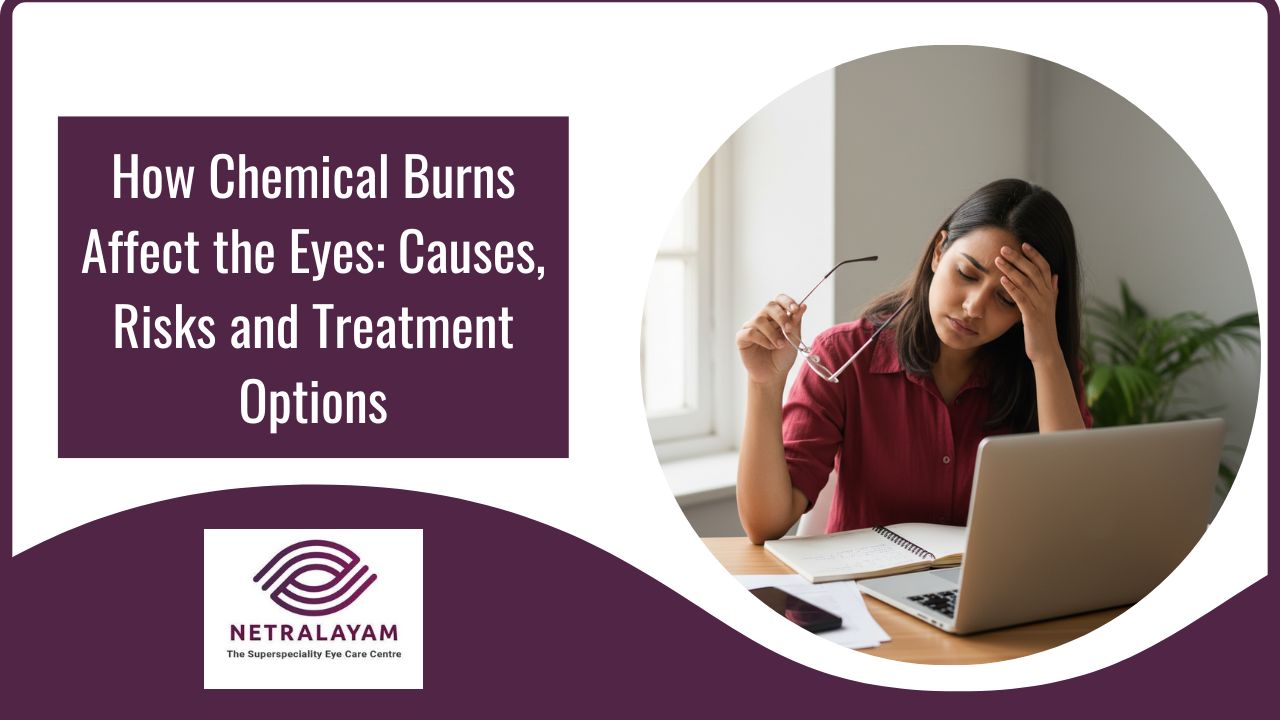Committed to Eye Care with Compassion, Technology and Competency
Committed to Eye Care with Compassion, Technology and Competency

10/14/2025
It only takes a split second for a chemical splash to turn into a serious eye emergency. Whether it’s a household cleaner, a lab chemical, or even battery acid, the damage can be immediate, and sometimes permanent. In fact, thousands of people each year experience chemical eye injuries at home or work. Knowing what causes these burns, how to recognize them, and what to do right away can save your vision.
Learn how chemical burns affect your eyes and what you can do to protect your vision.
A chemical eye burn occurs when a harmful substance, acidic, alkaline, or irritant, comes in contact with the surface of the eye.
When these chemicals reach the cornea (the eye’s clear front layer) or conjunctiva (the membrane covering the white part of the eye), they can trigger inflammation, swelling, and even tissue destruction, making immediate care critical.
Many household items can cause eye burns if splashed or mishandled. These include:
Always handle these products carefully and avoid touching your eyes after using them.
Work environments are another major source of chemical injuries to the eyes. Workers in industries such as manufacturing, laboratories, and construction are at higher risk due to:
Protective eyewear is essential to prevent exposure during such activities
Children are naturally curious, and that curiosity can be dangerous when it involves household chemicals. Accidental splashes from cleaning products or fertilizers are common.
Store all chemicals securely and out of children’s reach.
A chemical burn in the eye can feel like a sudden, searing pain. Common symptoms include:
In severe cases, the eye may appear white or cloudy (a sign of corneal damage), and vision loss can occur rapidly.
No matter how mild it seems, any chemical splash to the eye is an emergency, seek medical attention immediately.
When it comes to chemical burns, time is vision. Here’s what to do right away:
Prompt irrigation helps neutralize the chemical and prevent deeper damage.
Without proper treatment, the consequences can include:
Once you reach medical care, ophthalmologists or urgent care providers will take immediate steps to save your vision.
Doctors will flush the eye further, test the eye’s pH levels, and assess the extent of damage. Topical medications and lubricating drops are often started to relieve discomfort and prevent infection.
Depending on the severity, treatment may include:
Pain relievers and lubricants to ease irritation and promote healing
Severe burns may require advanced procedures like:
Regular follow-ups are vital to monitor healing and prevent complications.
Even a brief chemical splash can quickly turn into a serious eye injury. Acting fast, flushing your eyes, removing contact lenses, and seeking medical care can make all the difference. Stay vigilant when handling household or workplace chemicals, wear protective gear, and pay attention to warning signs. Quick action and simple precautions can protect your vision and keep your eyes safe for years to come.
Eyes are delicate, and accidents happen fast. Netralayam offers prompt treatment for chemical eye burns, helping reduce pain and prevent lasting injury. From first aid guidance to professional care, our team ensures your vision is safeguarded.
Book an appointment today, your eyes deserve expert attention and protection from the very first moment.
Rinse your eye with clean, lukewarm water or saline for 15–20 minutes. Remove contact lenses, avoid rubbing, and seek emergency medical care immediately.
Alkaline substances like ammonia, lye, and bleach are the most dangerous, as they penetrate deeper into eye tissues, causing severe pain, inflammation, and potential long-term damage.
Only an eye specialist can assess permanent damage through detailed eye exams, corneal evaluation, and imaging. Persistent vision changes or corneal scarring indicate possible long-term effects.
Prompt treatment improves recovery. Mild burns may heal completely with irrigation and medication, while severe injuries might require surgeries like corneal transplants to restore vision.
Use protective eyewear, store chemicals safely, follow instructions, avoid mixing cleaners, and educate children or employees on proper handling and first-aid measures.

Leave a Reply Cancel reply